A New Model for Resilient Coastal Parks
Economic resilience and ecological restoration fell hand-in-hand—the success of one goal relied on the success of the other at Gulf State Park
 Sasaki
Sasaki
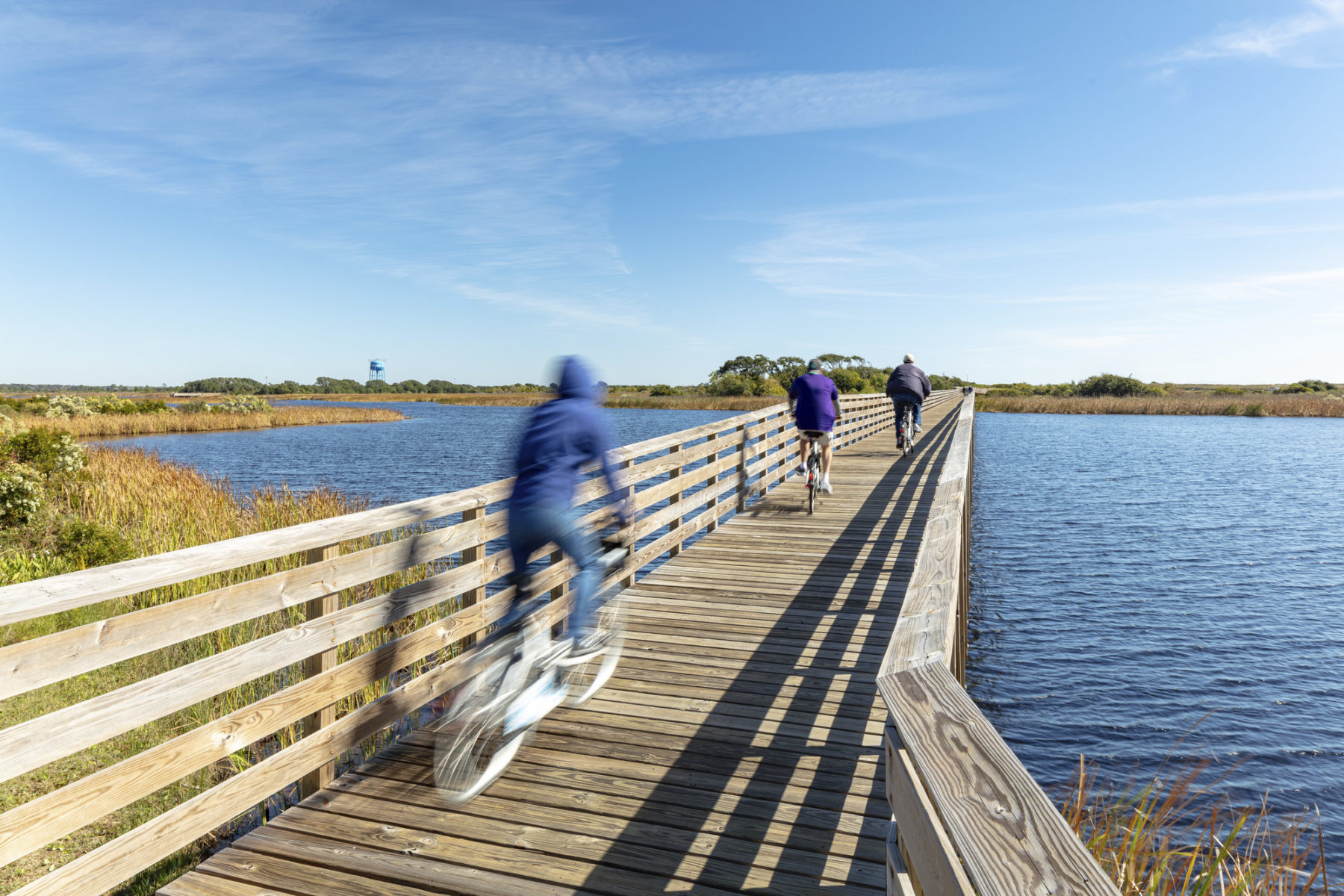
Gulf State Park Master Plan expands environmental education, overnight accommodations, and outdoor recreation while enhancing environmental sustainability and resilience
Funded through recovery dollars from the oil spill, the Gulf State Park Master Plan provides a roadmap for the 6,150 acre coastal state park that goes beyond recovery—taking advantage of oil spill recovery funding to enhance the future resilience of the park. Now, 10 years after the oil spill, the implementation of the master plan has positioned Alabama as an international sustainable tourism destination by bridging economic and environmental sustainability.
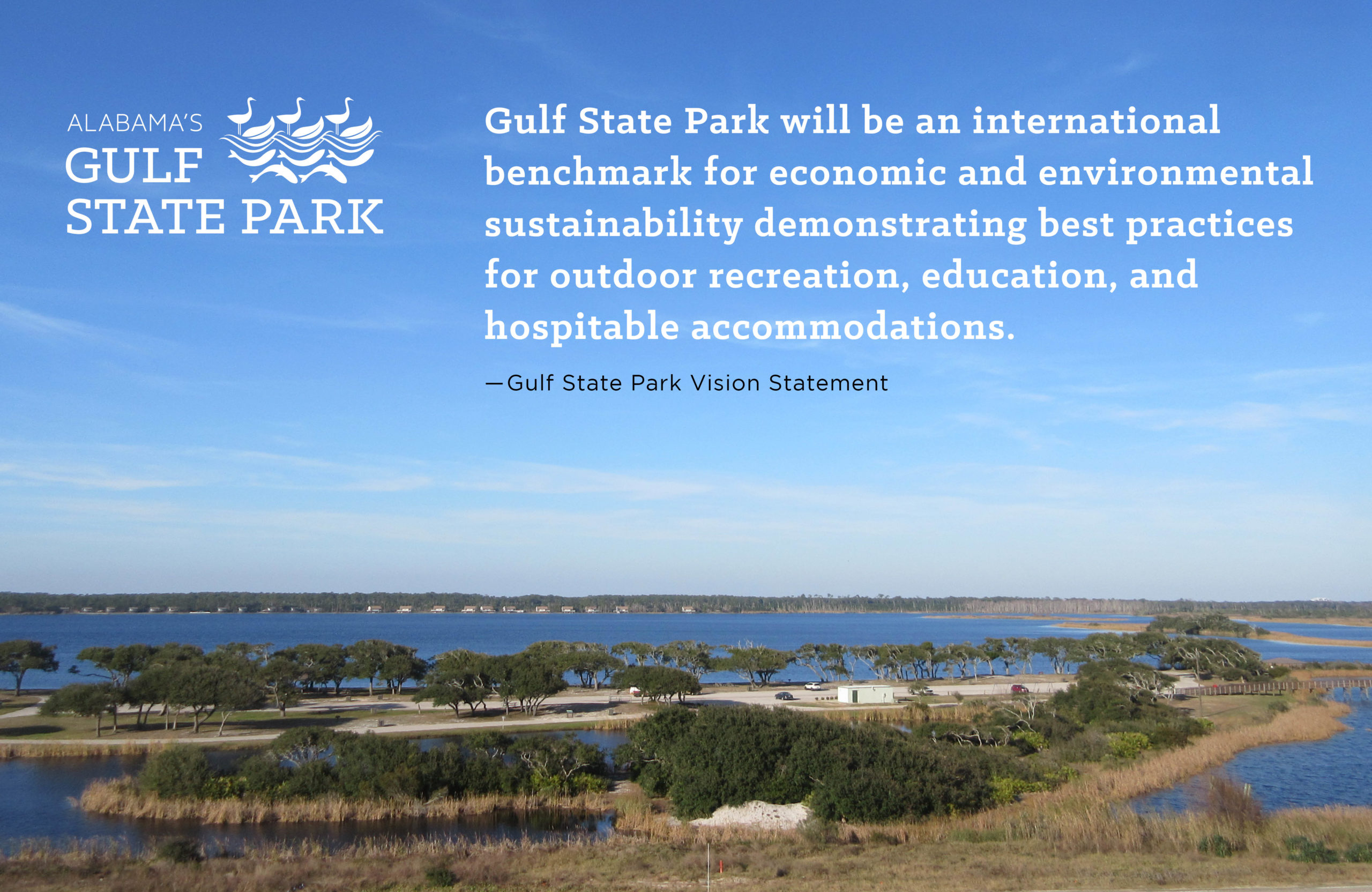
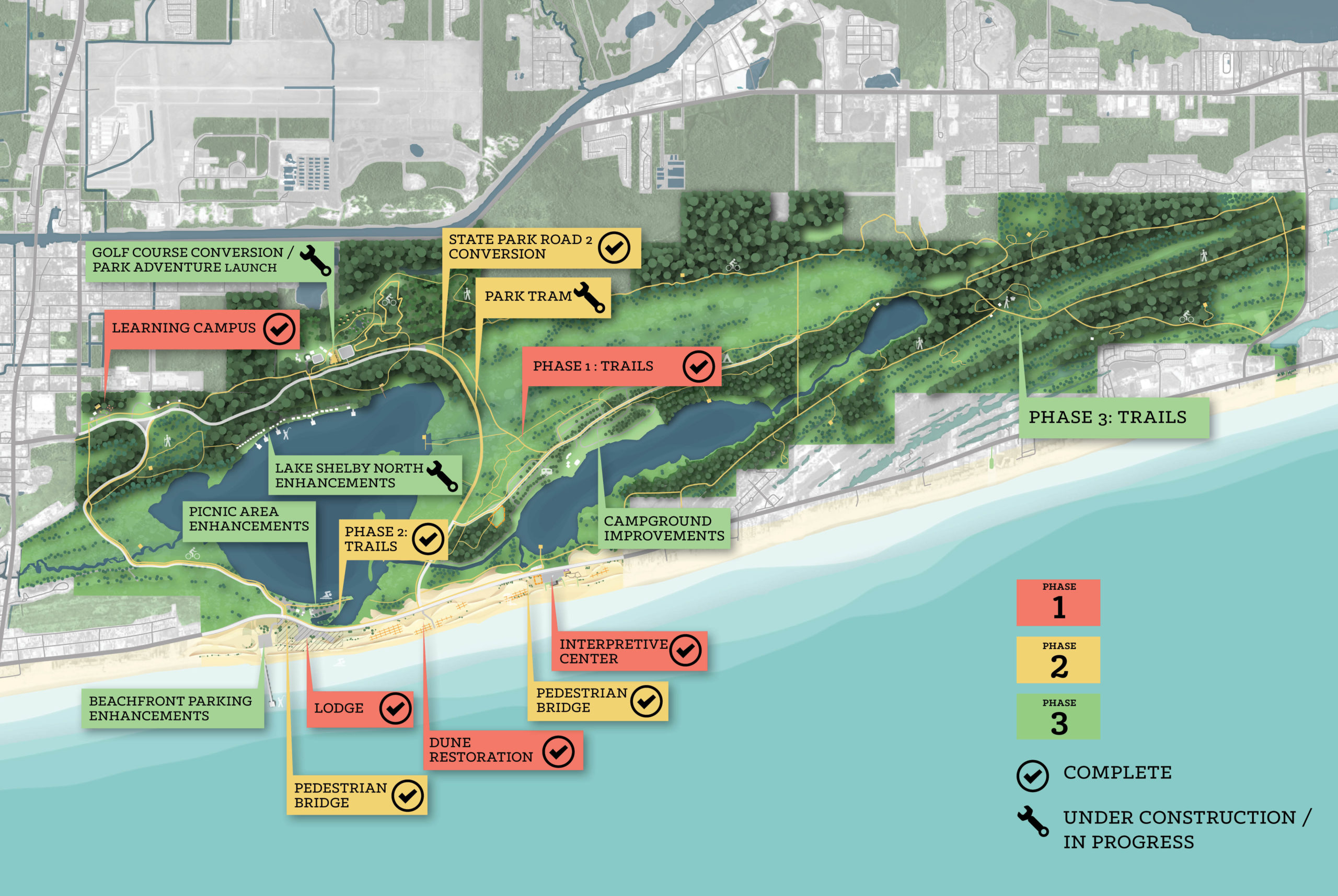
The master plan provided a roadmap to achieve a bold vision, transforming the park into an international sustainable tourism destination and improving Alabama’s national reputation. Many of the first and second phase improvements are now complete or in progress.
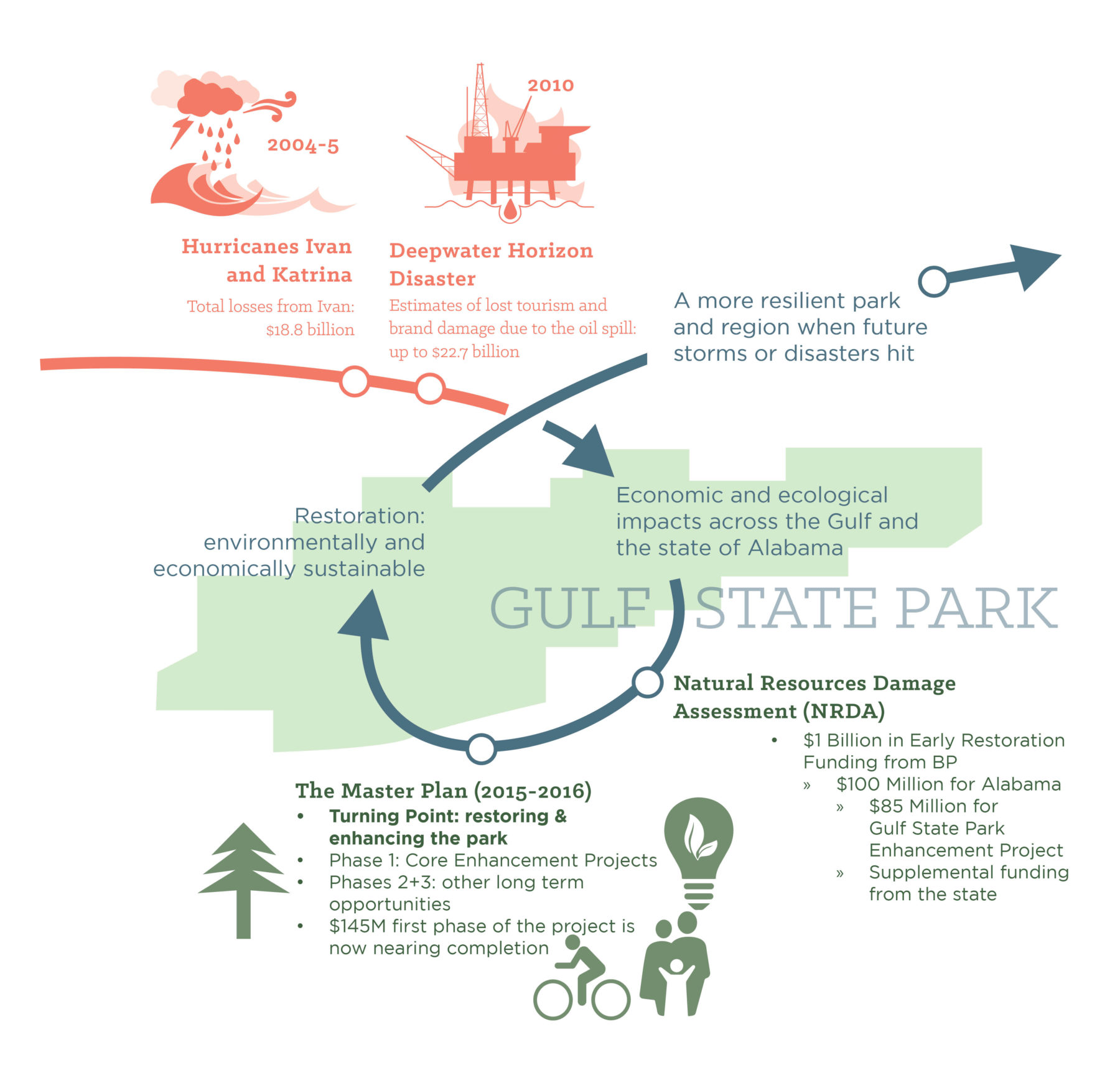
The Gulf State Park Master Plan and its implementation demonstrate the power of planning to effect positive change
Alabama’s Gulf Coast was hit hard by Hurricane Ivan in 2004 and the B.P. Oil Spill in 2010. As tourism numbers fell sharply during the oil spill, the community grasped an important lesson: the health of their economy depended on the health of their environment. This realization became the foundation of the Gulf State Park enhancement project.
From the start, this project was about going beyond rebuilding to create a new legacy for the state—expanding access to Alabama’s beautiful coastal ecosystems and outdoor recreation. The Gulf State Park project vision statement set an aspirational goal to have the project become “an international benchmark for economic and environmental sustainability demonstrating best practices for outdoor recreation, education, and hospitable accommodations.”
At 6,150 acres with seven different ecosystems, Gulf State Park is the largest protected open space on the Gulf of Mexico with such environmental diversity. A one-of-a-kind environmental resource, Gulf State Park and the local white-sand beaches are also a critical economic asset—the heart of the region’s tourism-fed economy. In 2014, this single park accounted for 23% of the total annual visitor revenue in the Alabama State Park System.
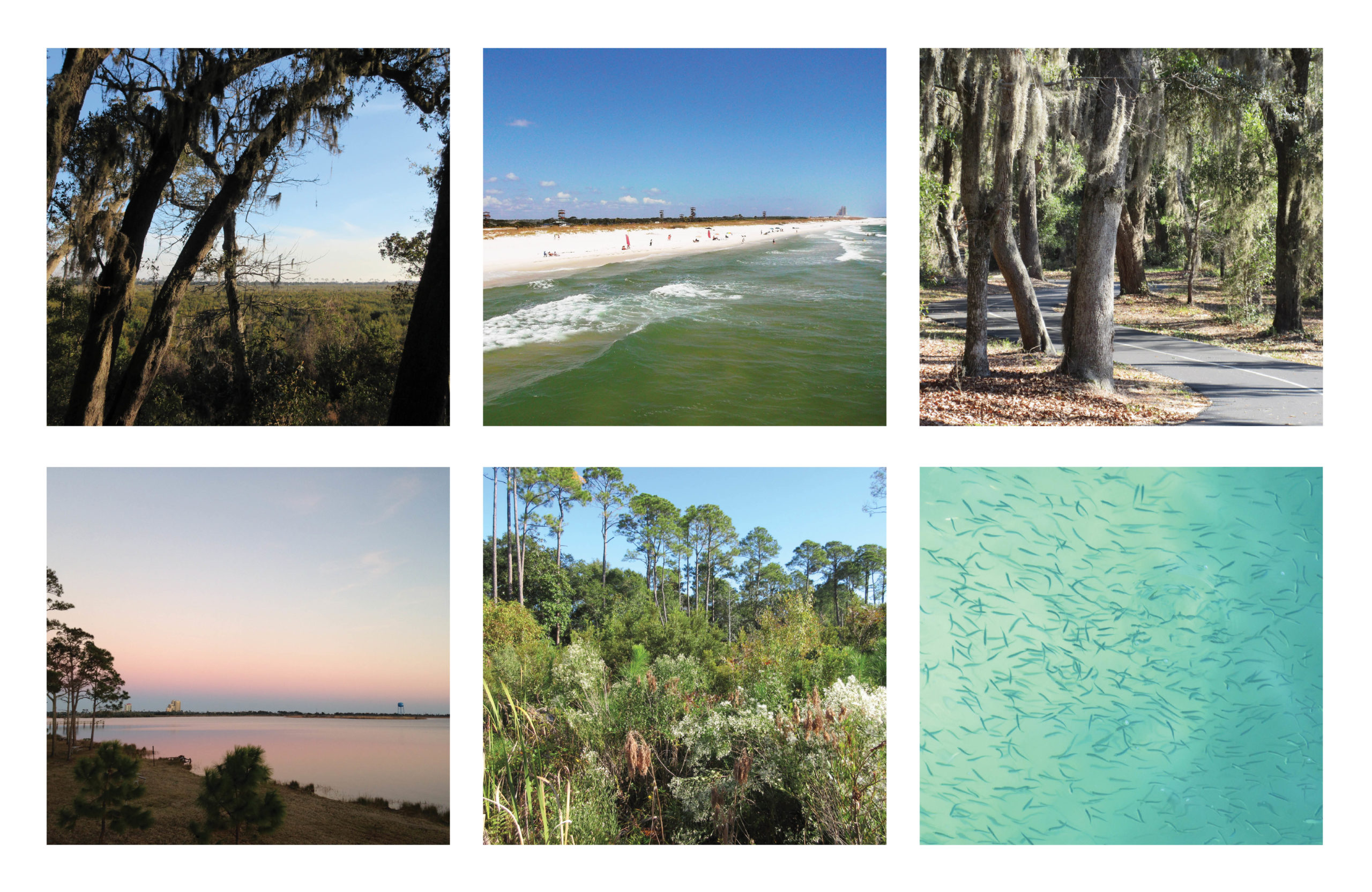
Home to the federally-endangered Alabama Beach Mouse and an important flyway stopover, Gulf State Park is a critical environmental resource encompassing a diversity of ecosystems
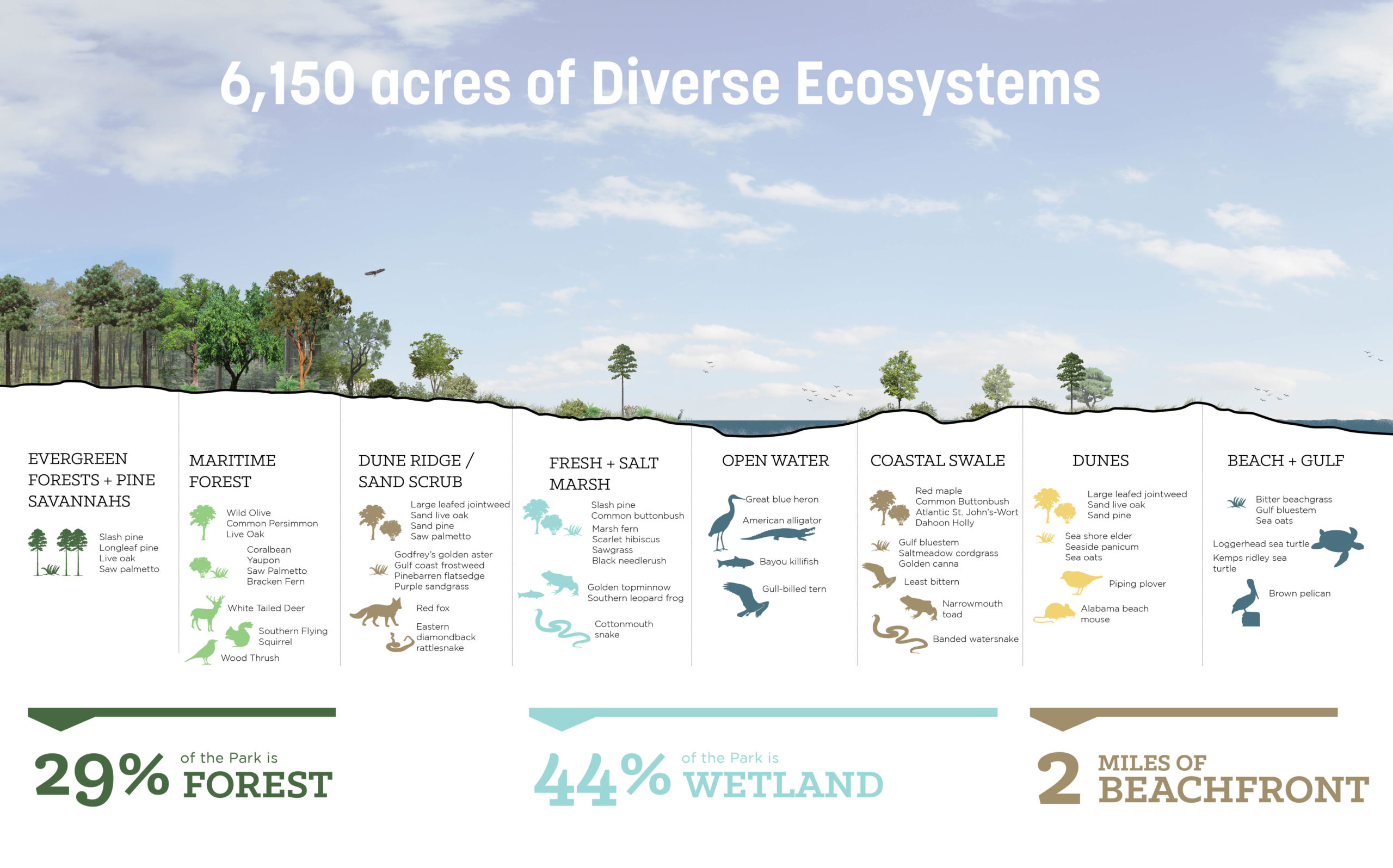
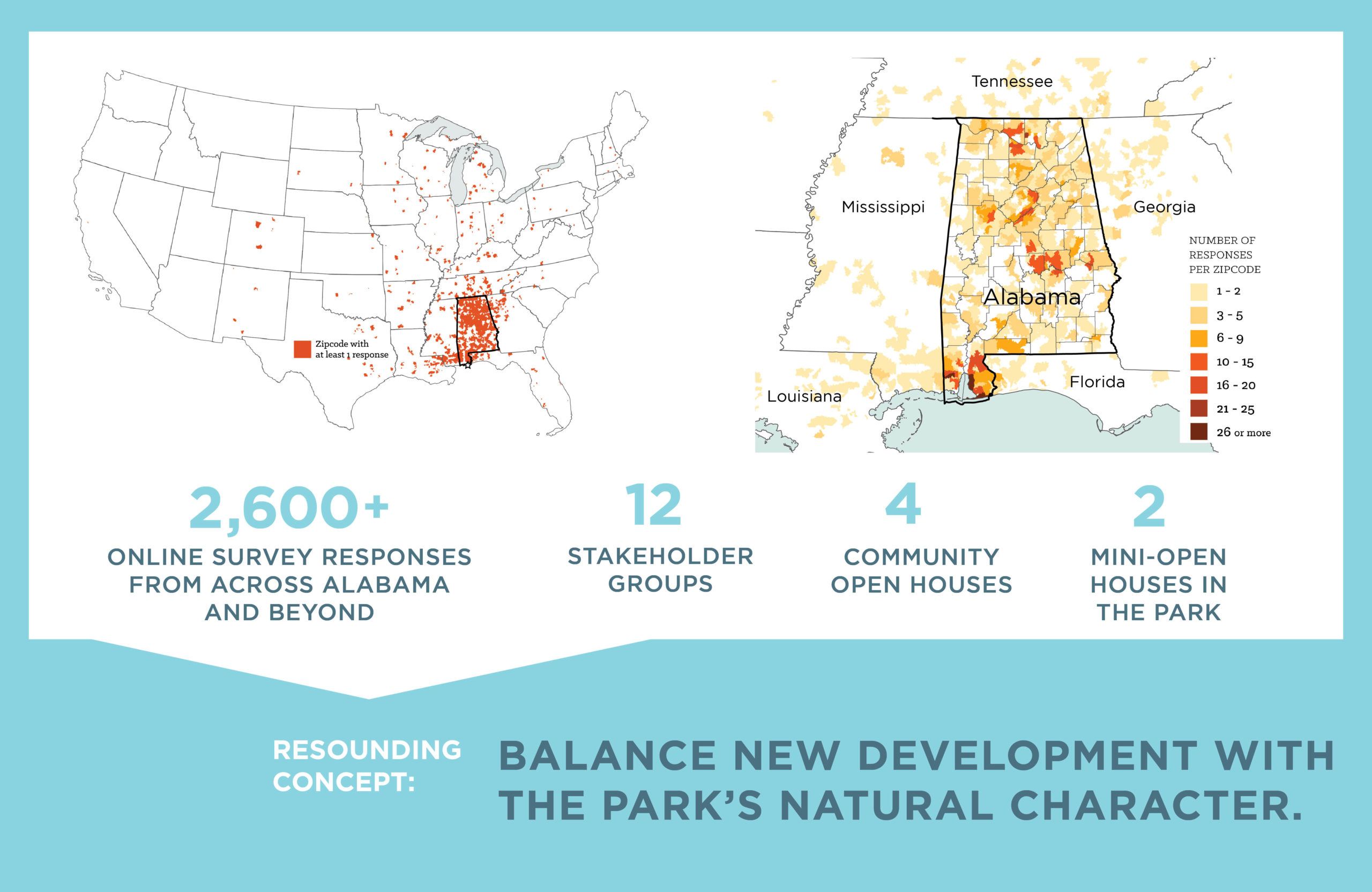
The team engaged with more than 3,000 residents and park visitors, including feedback from all 67 counties in Alabama and 34 states
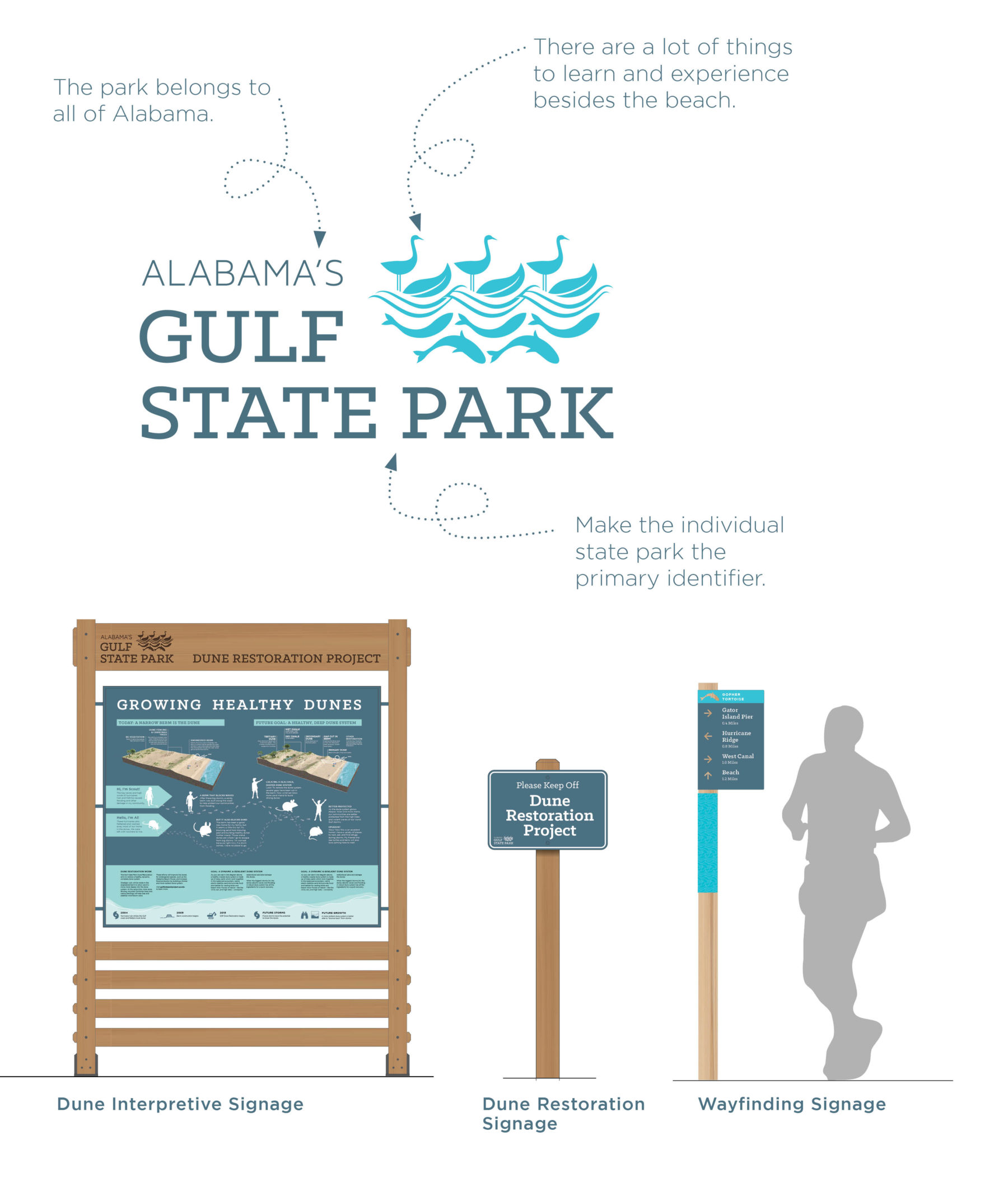
Developing a park brand that represented the diversity of the park as well as the core elements of the vision was a critical first step. Deployed throughout the park, the brand is now a recognizable and defining feature of the experience.
Implementation of Phase 1, totaling $140.5M, is now complete including:
These elements carefully balance new development in the park with its sensitive environmental ecosystems. The need to protect from “overdevelopment” was one of the top themes from thousands of park visitors who participated in the project’s diverse engagement opportunities. An online survey collected feedback from more than 2,600 residents, including responses from all 67 counties in Alabama and from 34 states.
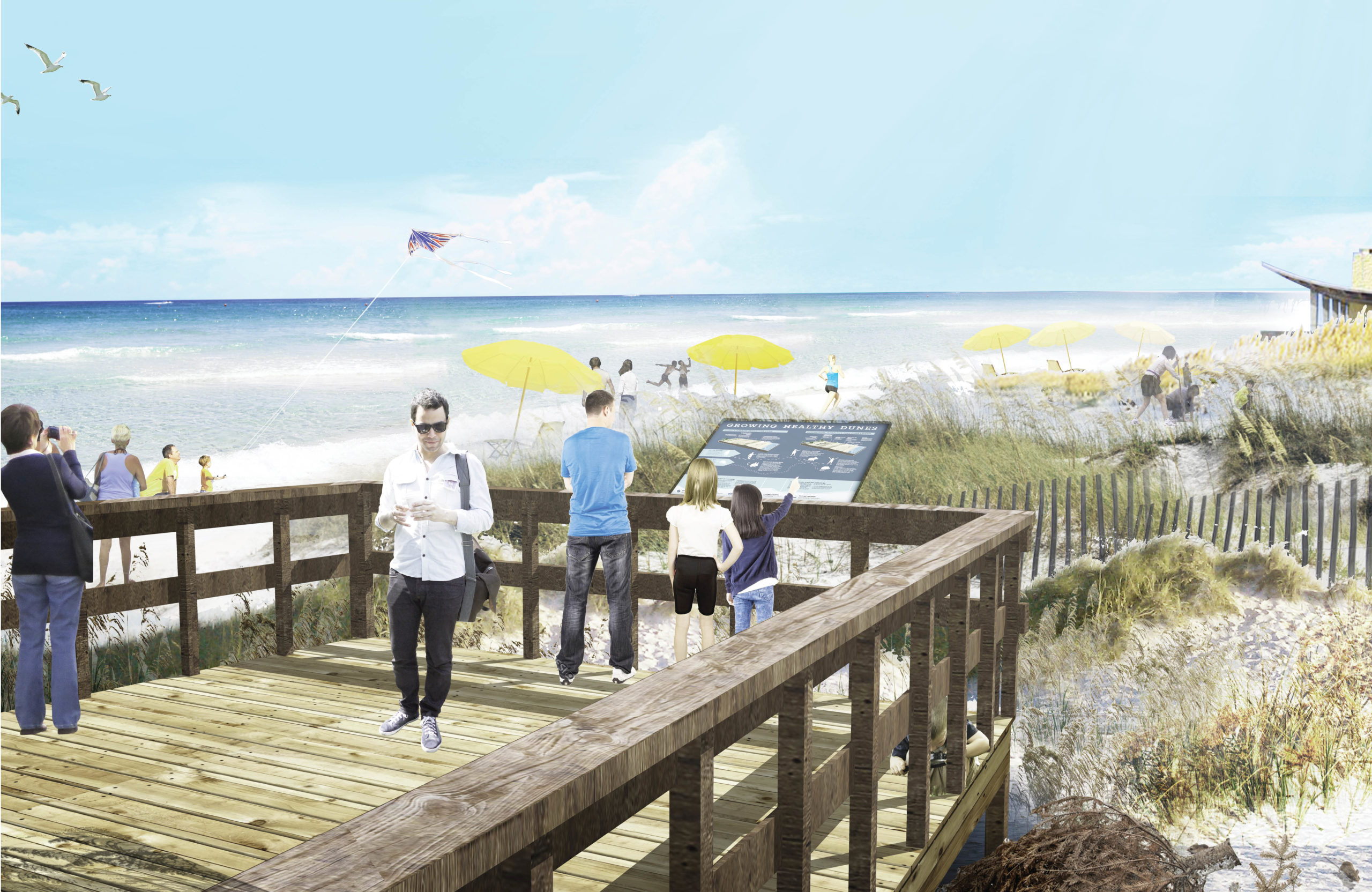
The master plan envisioned an interpretive center that would celebrate a healthy and dynamic dune system and teach park visitors about the park’s diverse ecosystems
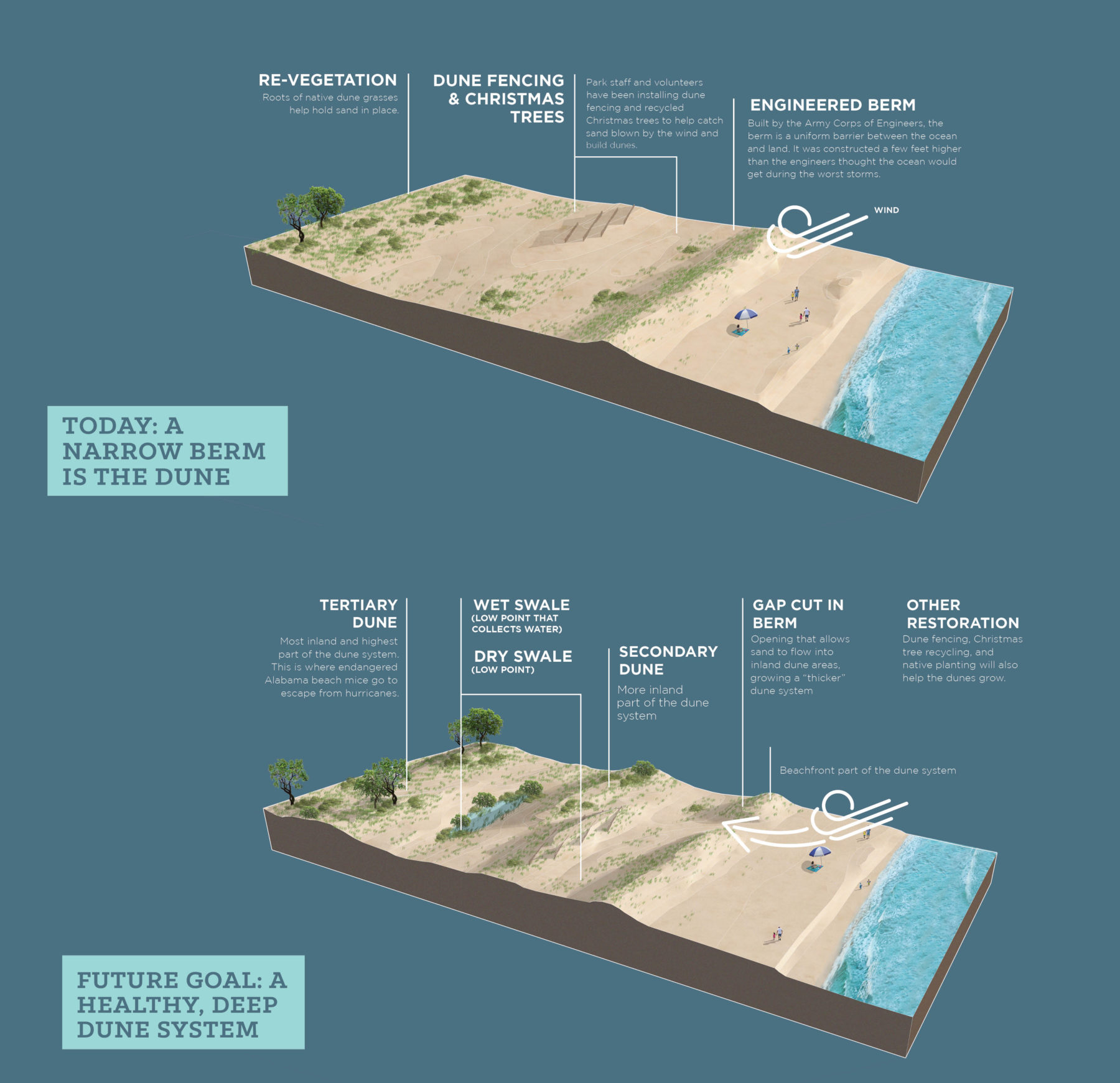
A tall engineered berm blocked natural sand movement. Five cuts were made in strategic locations, allowing sand to move naturally and restoring secondary and tertiary dunes.
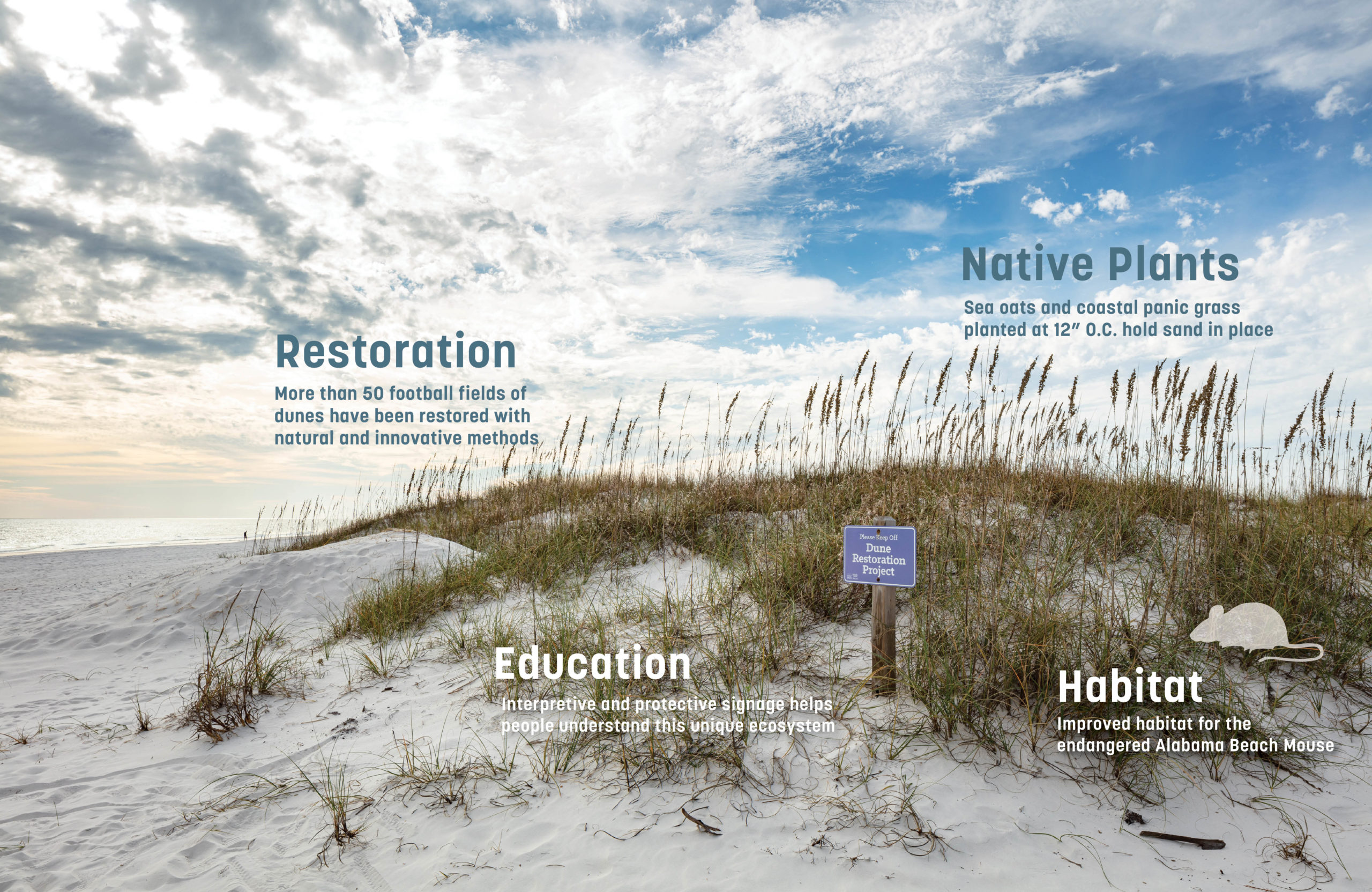
Implemented dune restoration projects are helping to grow healthy dunes that provide important habitat while protecting the park and surrounding community from storm events
The master plan envisioned an interpretive center that would celebrate a healthy and dynamic dune system and teach park visitors about the park’s diverse ecosystems
A tall engineered berm blocked natural sand movement. Five cuts were made in strategic locations, allowing sand to move naturally and restoring secondary and tertiary dunes.
Implemented dune restoration projects are helping to grow healthy dunes that provide important habitat while protecting the park and surrounding community from storm events
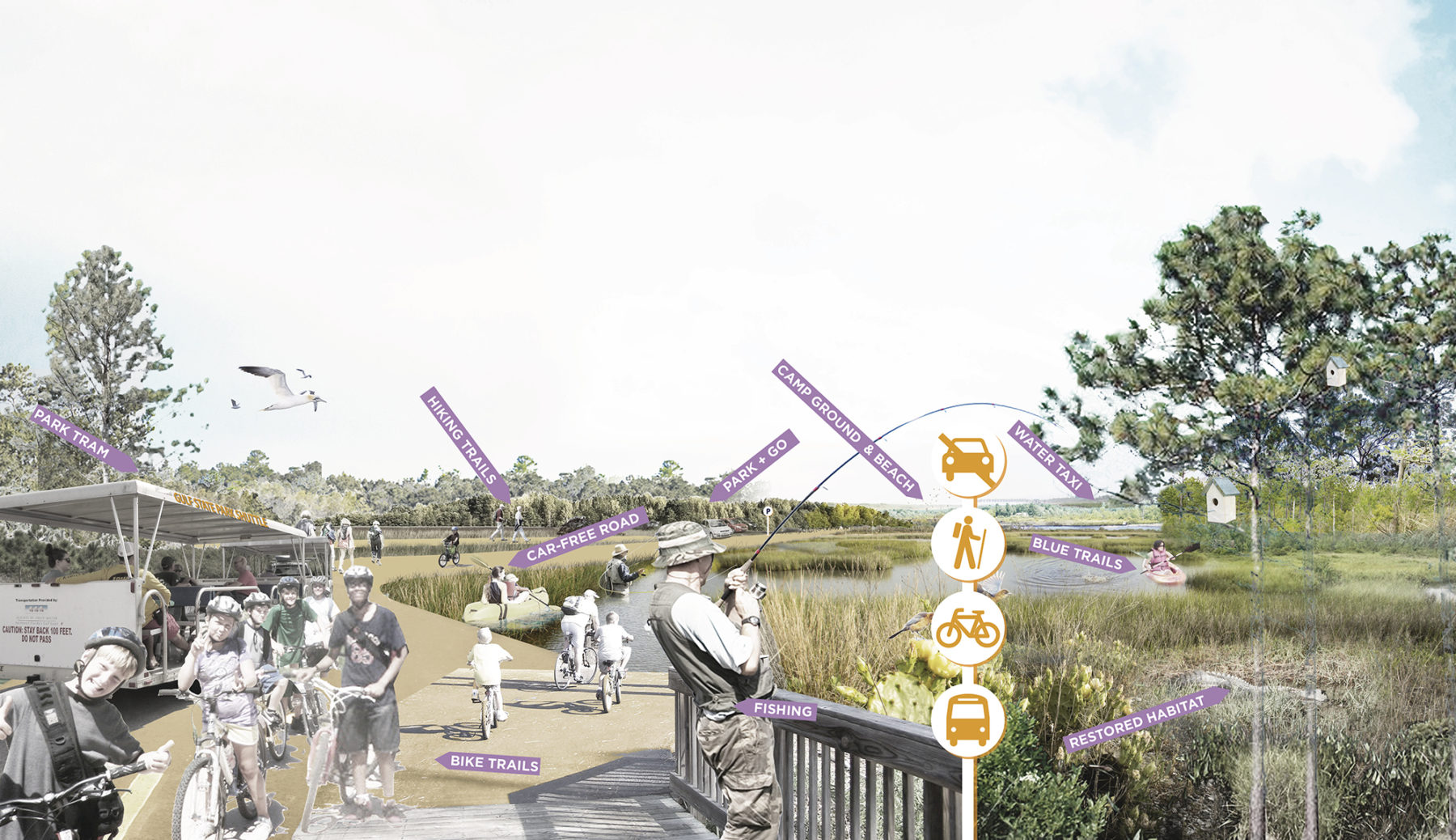
Parking once to explore via bike and foot was an important theme of the master plan vision
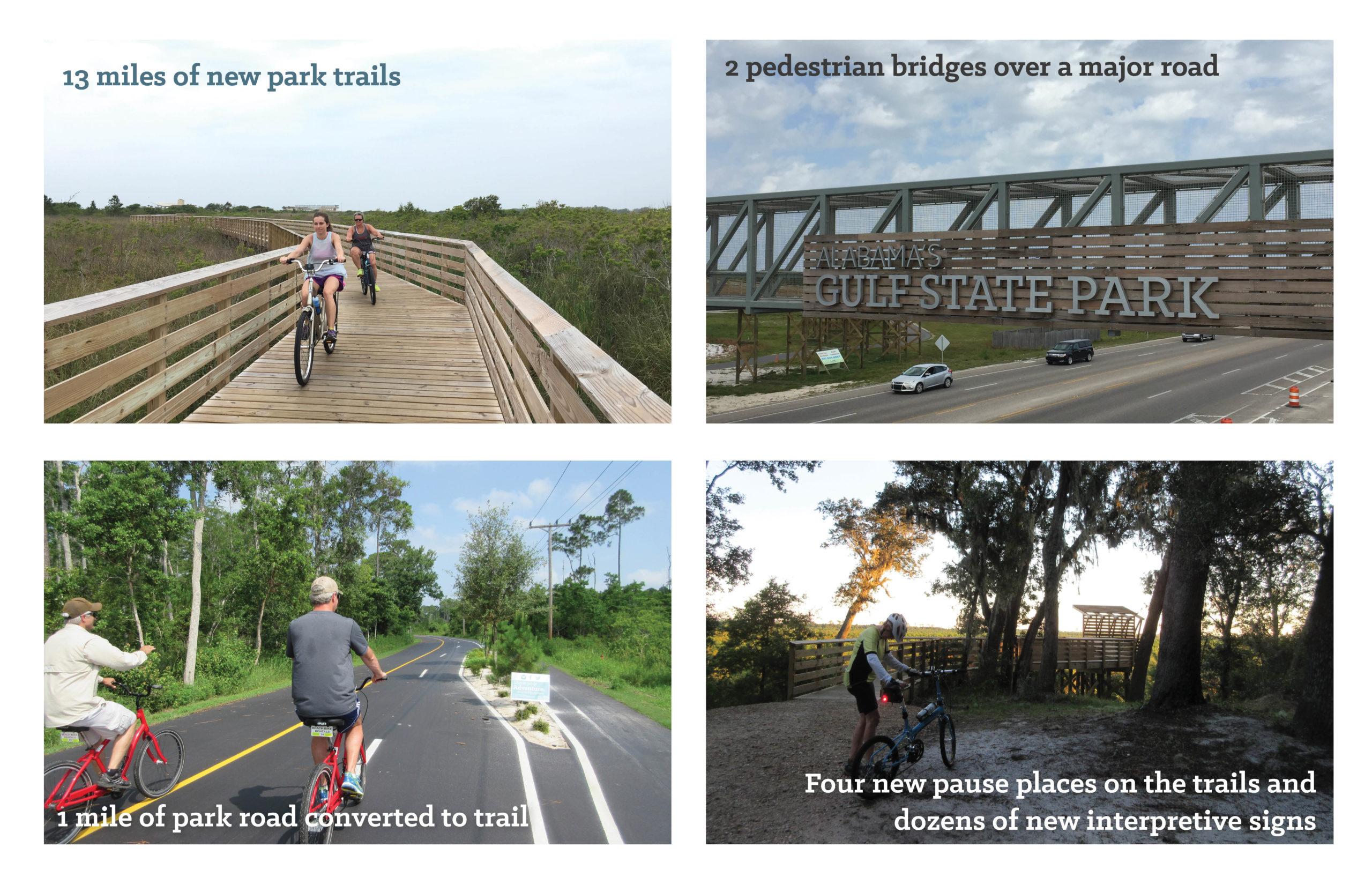
The park has already implemented many of the phase 1 and 2 improvements of the master plan
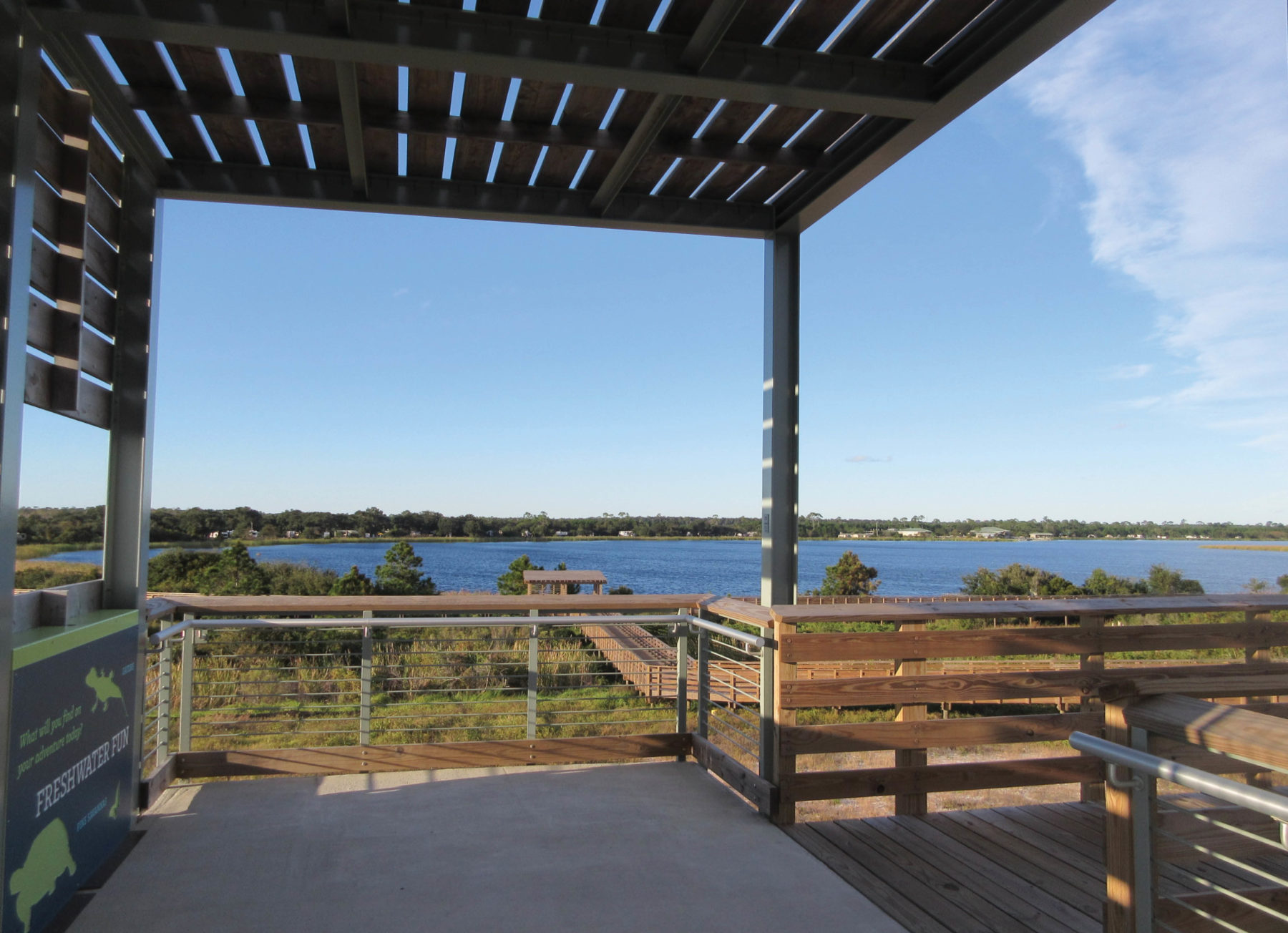
The new trail system reveals and connects some of the park’s most beautiful moments
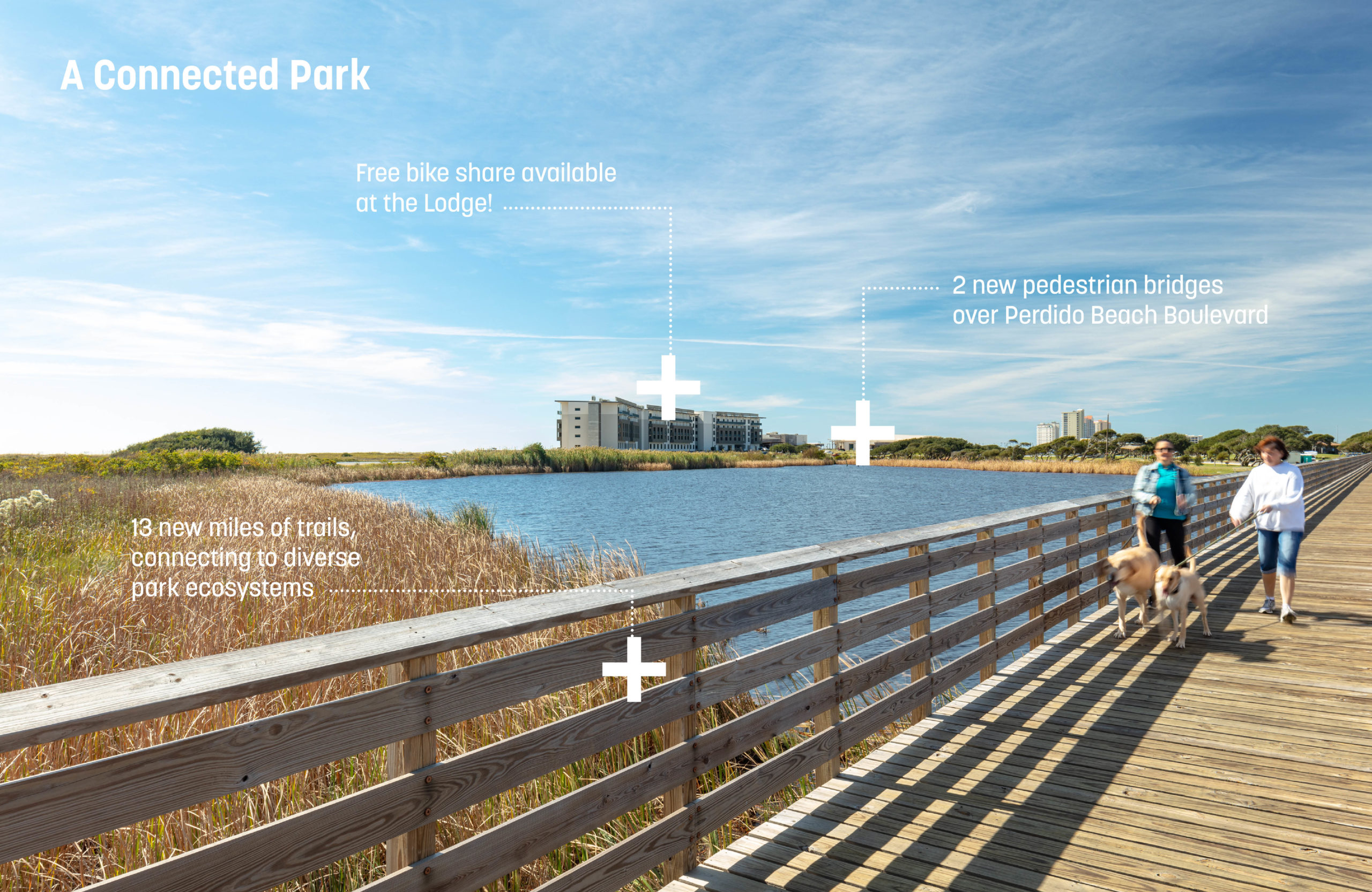
An expanded trail network includes 15 miles of new trails and 2 pedestrian bridges over a major beachfront state road, making it possible to travel between all major park destinations by bicycle or by foot
The Gulf State Park story is writing a new narrative about Alabama. The recent park investments have positioned Alabama as a leader in the national environmental sustainability conversation. When the Interpretive Center opened in May 2018, it became the first building to open in the southern U.S. on track for full certification under the Living Building Challenge (only 21 buildings across the globe currently meet this standard). Just up the beach, the Lodge is the first hospitality building in the world to achieve SITES Platinum certification. The Lodge and Interpretive Center are also the first commercial buildings in the world to receive designations as FORTIFIED structures, which measures a building’s ability to withstand hurricanes.
Both projects built on an extensive dune restoration program which implemented innovative natural strategies across 50 acres to grow an ecologically healthy, dynamic, and protective dune system for the park and community.
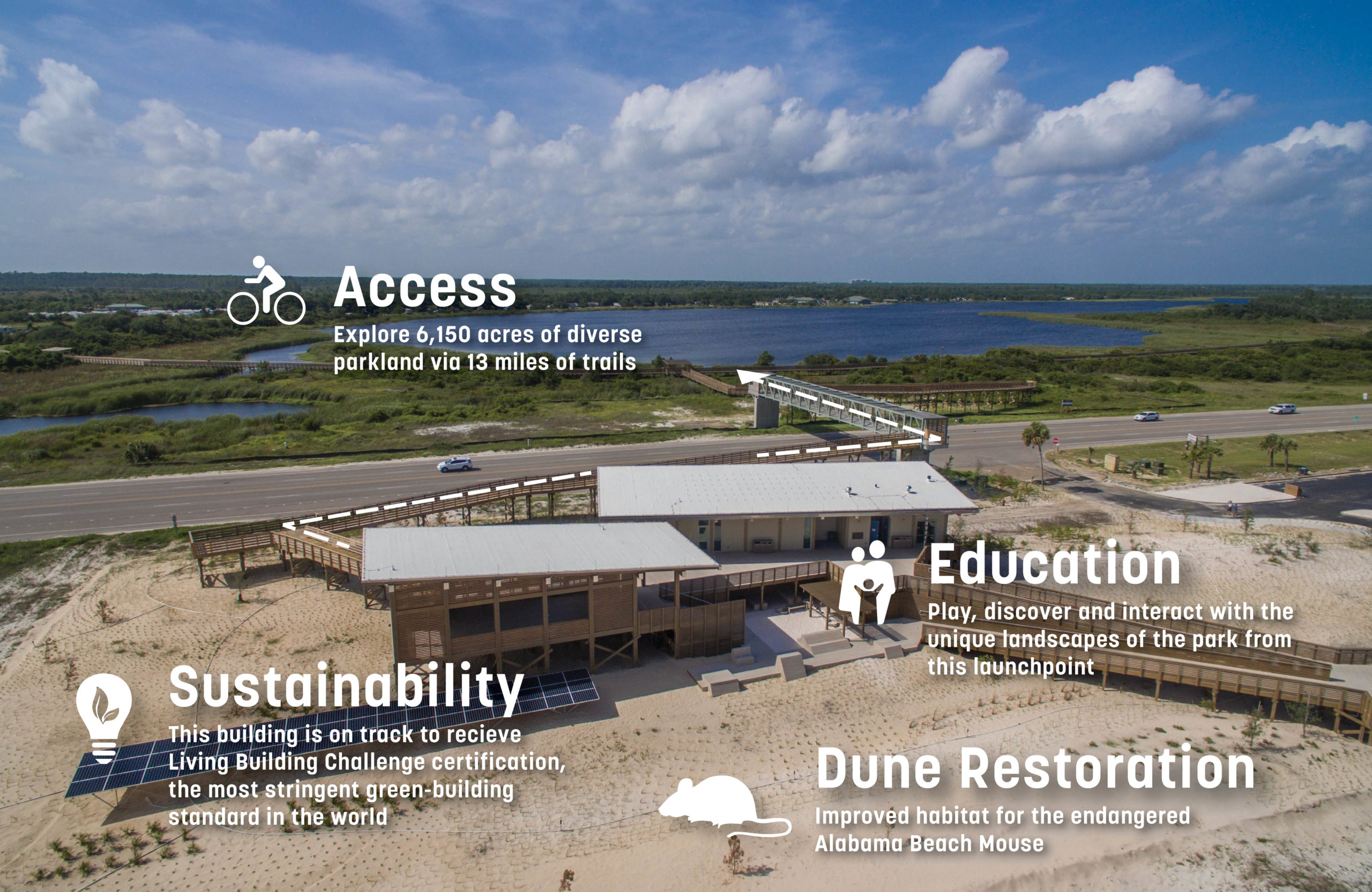
The new Gulf State Park Interpretive Center is on track to be one of just 21 certified Living Buildings in the world, demonstrating innovative best practices in sustainable development
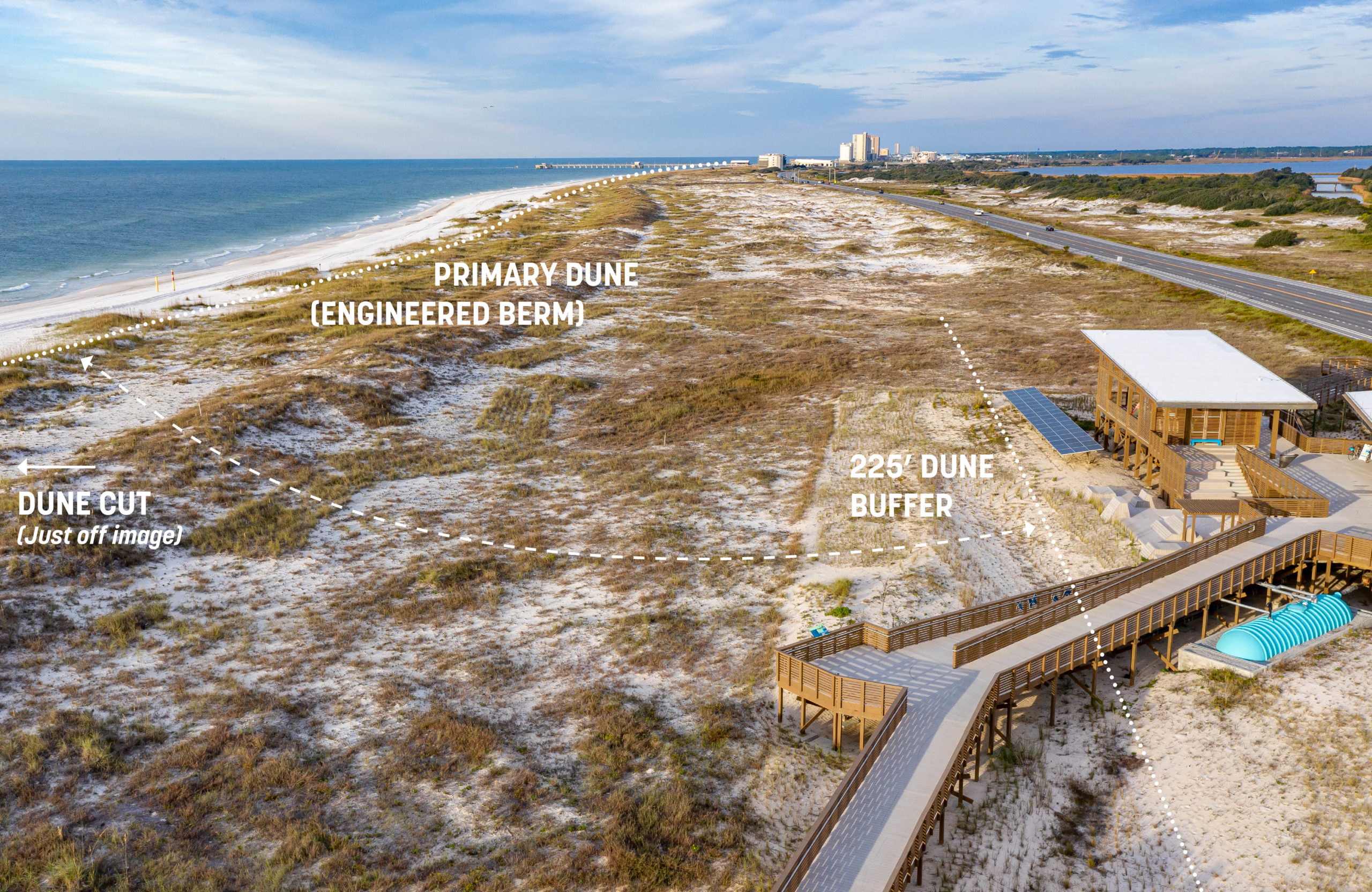
The Interpretive Center and the Lodge occupy formerly developed sites within a gulf dune system, but maintain a buffer from the primary dune to allow for dynamic dune growth over time
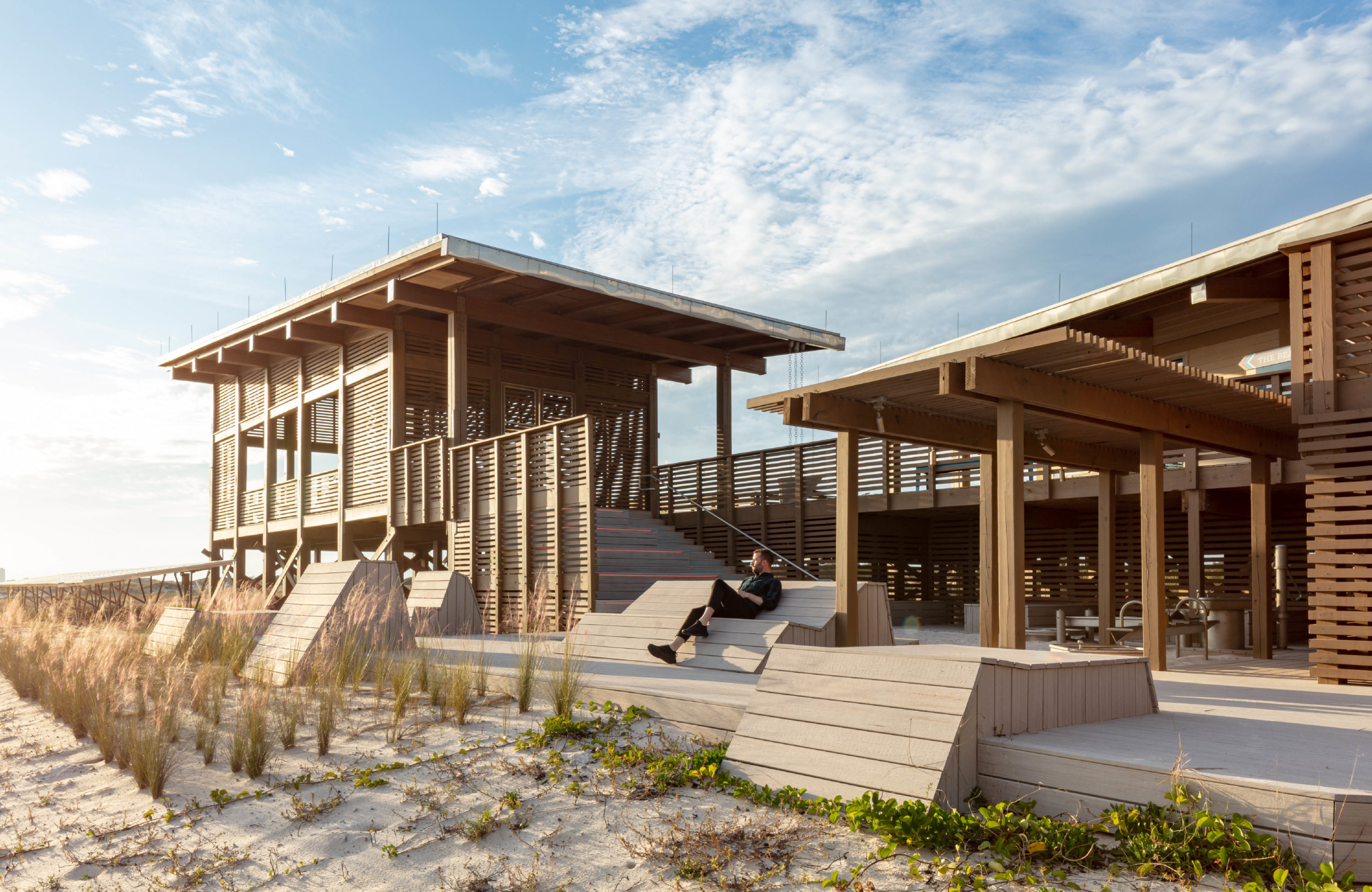
Although the interpretive center building sits high above the floodplain, accessible moments within the center allow for interpretation of the site’s growing dune system
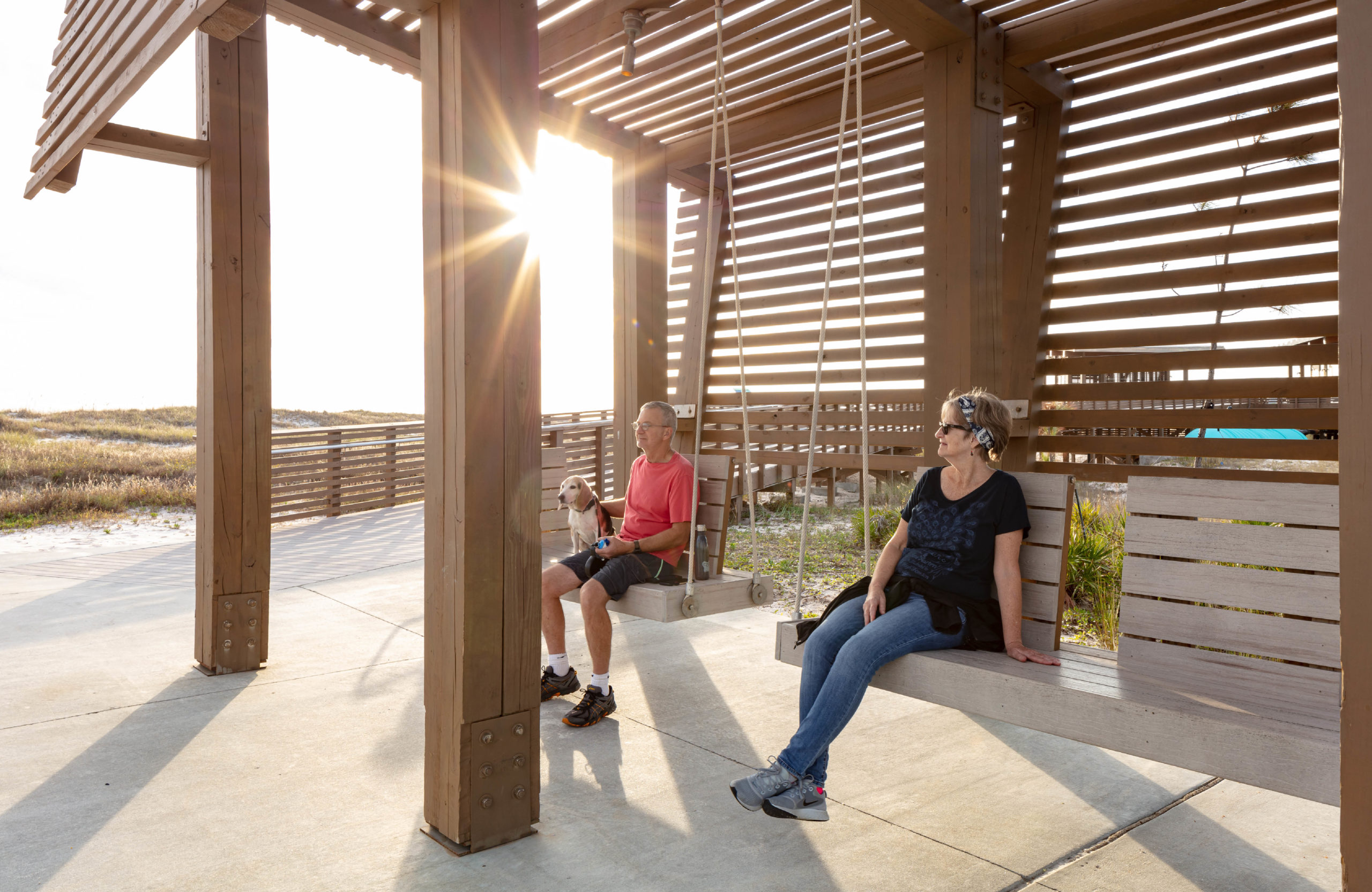
Swing benches at the beach plaza allow visitors to take a shady pause from their adventures through the park
A common misconception is that too much focus on the environment will hamper economic growth. The Gulf State Park Master Plan and its implementation is debunking this myth by demonstrating how a healthy environment can expand a local economy. The master plan’s “environment-first economic development” strategy has enhanced the park as an international sustainable tourism destination, opening up the local tourism economy to a new market sector. By purposely blending environmental sustainability with economic objectives, the park is pioneering an integrated model of resilience where environmental sustainability is also a path for economic success.
The Gulf State Park Master Plan and its implementation are demonstrating the power of park improvements to create positive change for a park, region, and state—and to reconnect people to nature, one new memory at a time.
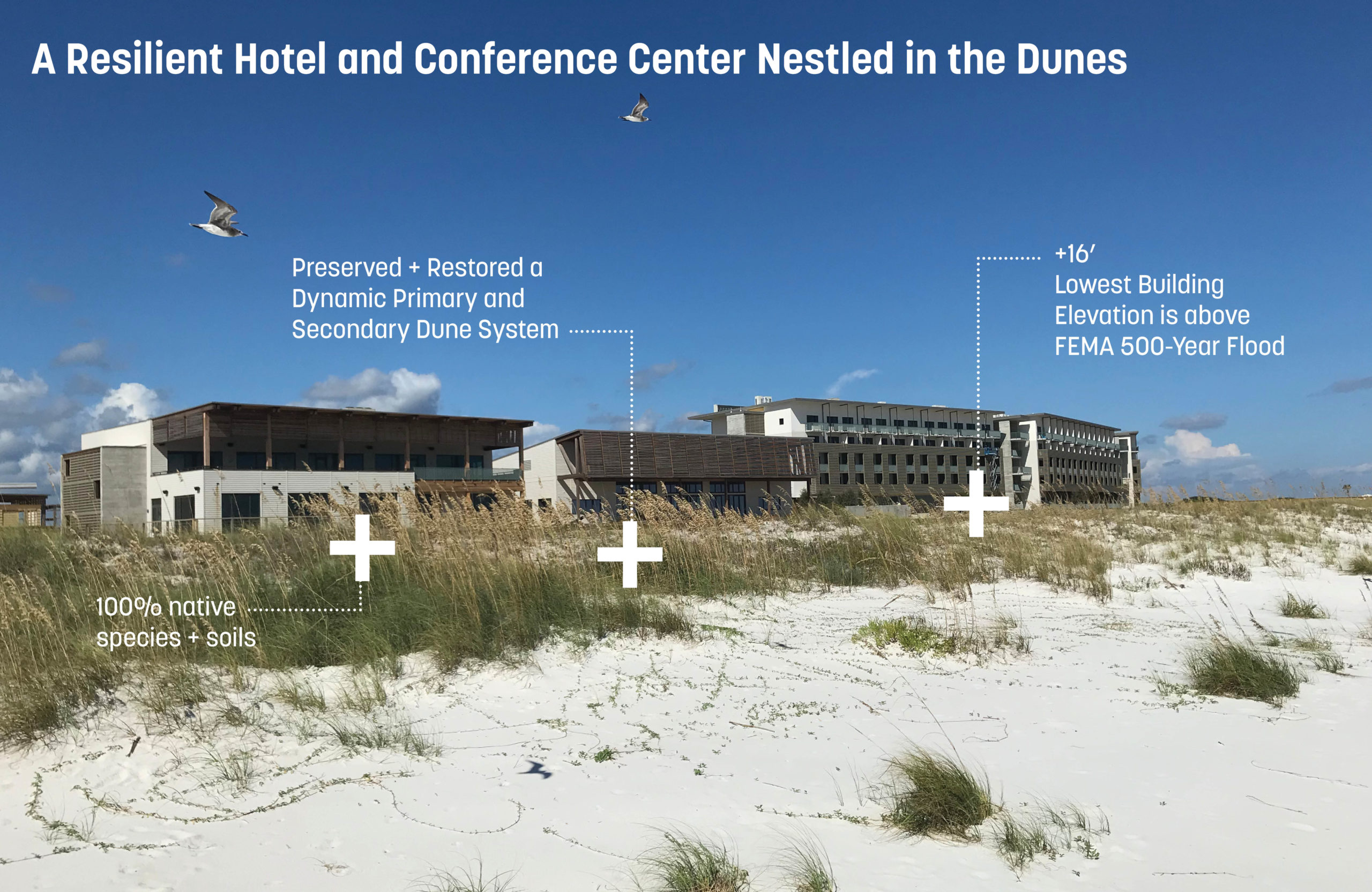
As the first hospitality building to certify as both SITES and LEED Platinum, the Lodge welcomes visitors to a unique experience of sustainable tourism at the edge of the Gulf
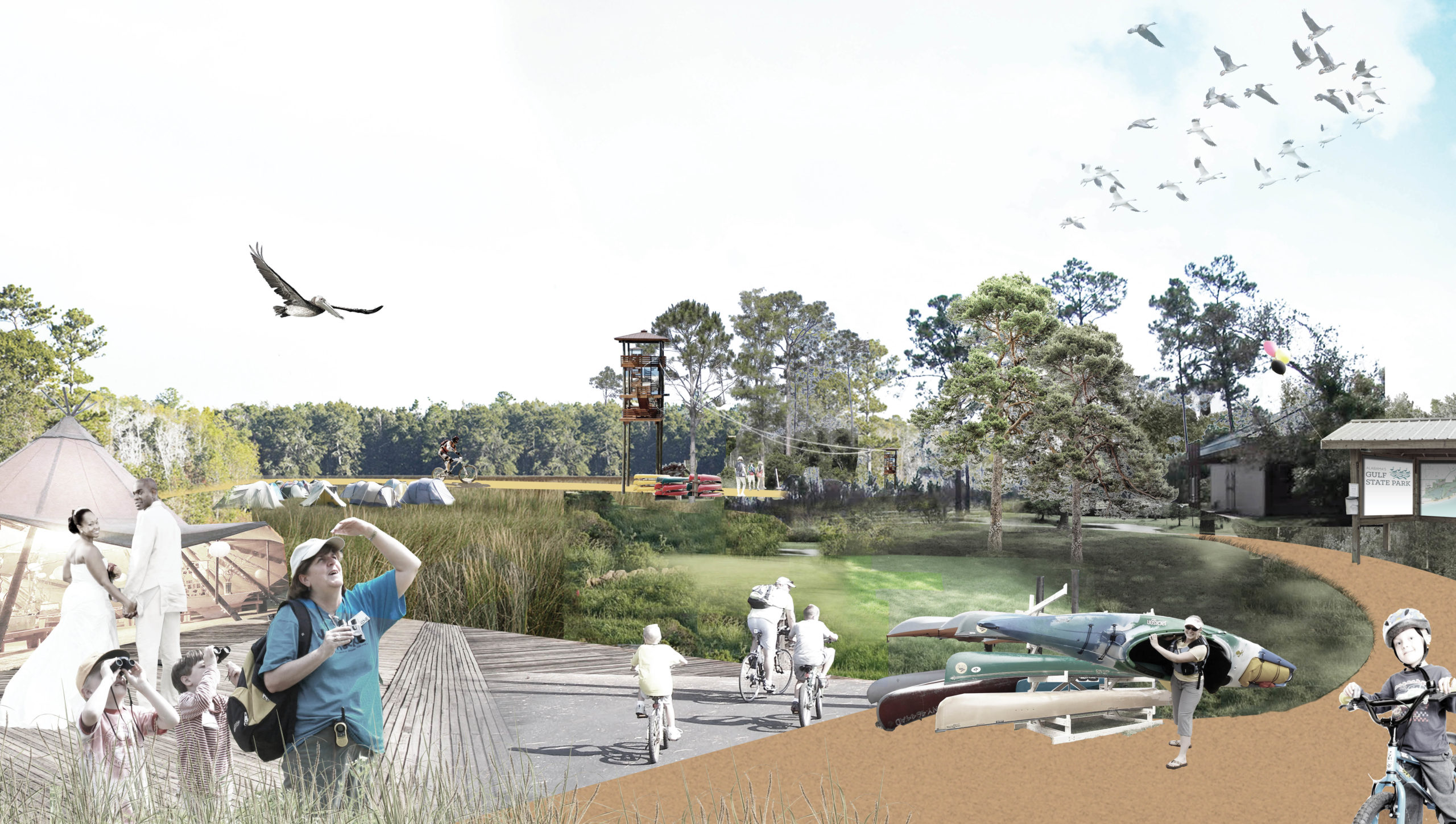
Future enhancements include converting the Golf Course to a “Park Adventure Launch.” The existing Golf Course was struggling financially and was closed in December 2018.
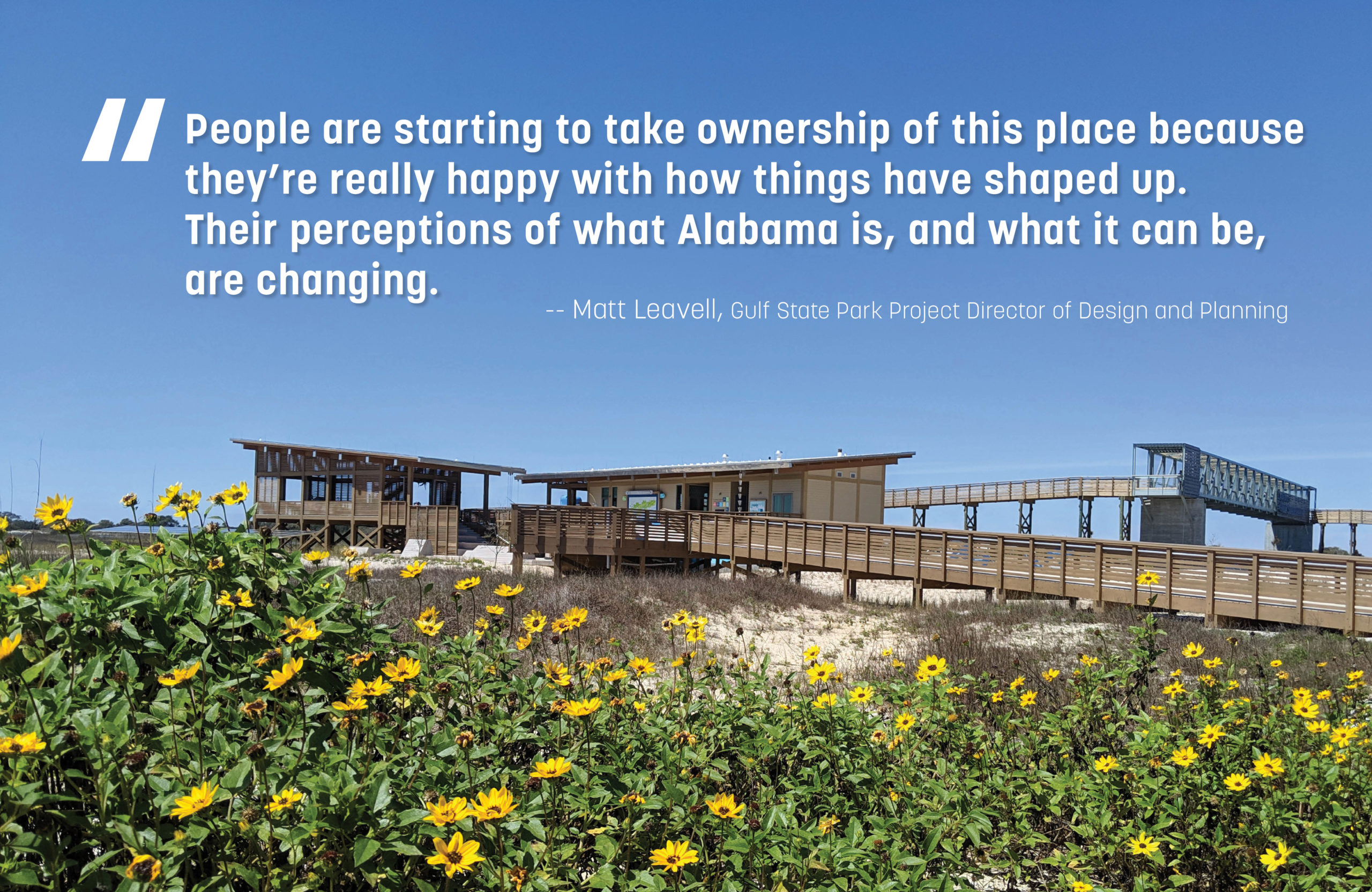
Sasaki led the master plan including the engagement process, designed the new park branding, and completed landscape design for the Lodge, Interpretive Center, and Learning Campus. Sasaki was also engaged for on-call planning support through implementation to advise as issues arose and to support with implementation progress. The results of the project show how an interdisciplinary approach to the project support faster, more integrated implementation. Sasaki’s team included planners, landscape architects, civil engineering, graphic designers, and computer programmers and data analysts (who developed SmartPark 1.0, a park revenue tool, for this project).
Economic resilience and ecological restoration fell hand-in-hand—the success of one goal relied on the success of the other at Gulf State Park
“Environmental leader” has not been a phrase many would use to describe Alabama. Now, thanks to Sasaki's work on Gulf State Park, it will.